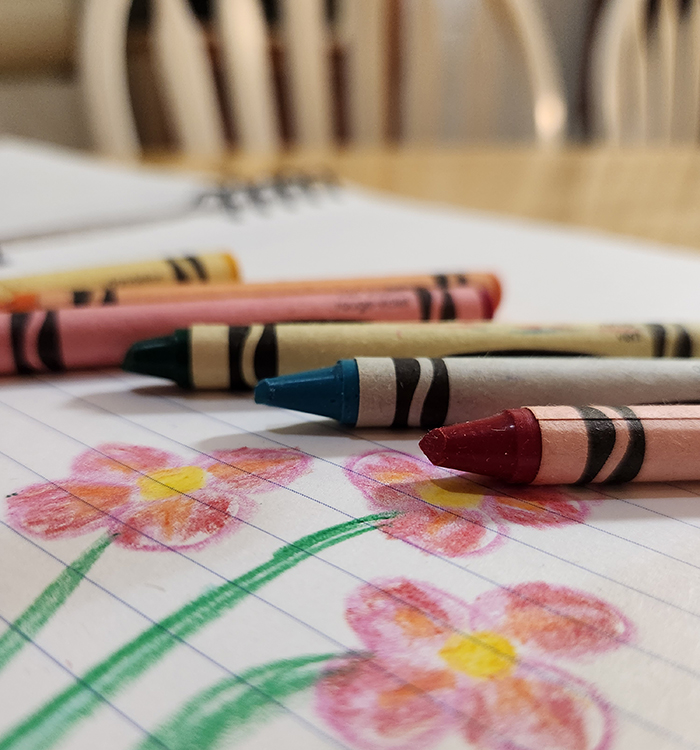Learning to Waste Materials and Time in the Service of Joy

When my children were small I filled my house with paper and crayons. The crayons outlasted the boxes they came in, so I ended up with a plastic bin full of loose (often broken) crayons. Construction paper and tape entered our house in bulk packs. There were even craft boxes deliberately full of interesting bits and bobs. These things existed in my house not because I looked forward to the results of my children’s crafty endeavors, but because making things was a source of joy to them and they learned from each thing that they made. Fine motor skills, cutting skills, learning to visualize 3d structures out of flat materials, all of these things helped my children to grow, to expand, to learn. I cheerfully tossed crayons and paper and tape and scissors onto the altar of that growth. The growth was the point. It was worth the expense. I’ll admit that I did at first go for the cheapest materials, so that the day my child discovered that crayon melting was creatively more interesting than drawing I was able to smile and hand them the bin of broken half crayons. (And also show them how to put down some wax paper so the melting didn’t stain the table.) But the stains were also part of the learning, both theirs and mine.
As the kids got older, the materials got more expensive. There were pastels and oil paints and construction sets and blocks of wood. Rented musical instruments came and went in my house. As did dance shoes and sports gear. Lessons were paid for and the end result was not gymnasts or equestrians, or musicians, or soccer stars, it was people who had learned from their curiosity and then moved on to something else.
I wonder why we as adults can’t grant ourselves the same grace to explore as I gave to my children. Somehow we get the idea that that the determining factor between “waste” and “well spent” is the result rather than the process. Partially this comes from the fact that we now have to pay our own bills and the creative materials must come from the same funds as food for our tables. When resources feel scarce, we are wary how we spend them, making sure each resource is optimized and carefully used to purpose. But what if the purpose was “personal growth” instead of completed and useful object. I love the idea presented by twitter user @mykola in this thread about being curiosity motivated instead of completion motivated:
“Your projects are your way of asking the universe a question, and then digging and digging and digging until the universe answers. You are motivated by curiosity, and that is a blessed gift, not a source of shame. Your unfinished work is the testament to your growth. Those aren’t abandoned projects — those are the remaining scaffolds from the the space ships that they launched. It was never about finishing the thing.”
A scaffold is not wasted, even if it is completely abandoned, but also perhaps we can reclaim the resource of empty space in our homes and brains by dismantling the scaffolds for parts, discarding and letting go of the pieces which can’t be salvaged or that we don’t want to take time to salvage. Even if we hold onto the scaffolds because maybe we’ll finish them later, we can certainly let go of the guilt around them. Because carrying guilt is a use of brain energy that is far more wasteful than any use of materials could possibly be.
Some projects are cathedrals meant to stand as a beautiful monument for many to admire. Other projects are sand castles where the result is inherently ephemeral and the point is the creation rather than the result.
Pulling this back to the very idea of waste, the dictionary definition of that word says “waste: use or expend carelessly, extravagantly, or to no purpose”. When we use materials or time or money for something that we enjoy, that is not a careless expense, though it may be extravagant. Joy often is extravagant, but it is definitely not “to no purpose.” Joy is purpose enough. Personal growth is reason enough. Just because we’ve become adults and exited formal schooling doesn’t mean we should stagnate our growth. Exactly the opposite. Be the sort of parent for yourself that buys piles of crayons and paper merely because you want to grow. Feel free to make a creative project out of sourcing materials in ways that don’t strain your budget nor make you worry about the environmental costs of your creative work.
Always remember that growth requires taking up more space and more resources than you did before. It is a good thing. Materials used in the service of your growth are not wasted. Enjoyment and growth are sufficient outcomes. Your growth is reason enough to spend resources on. Your enjoyment is reason enough.
The topic for this post was chosen by my Reader and Creative Community level supporters of my Patreon. If you have a topic you’d like to see me cover, becoming a supporter allows you to participate in the choosing of my next topic. Thank you for reading!